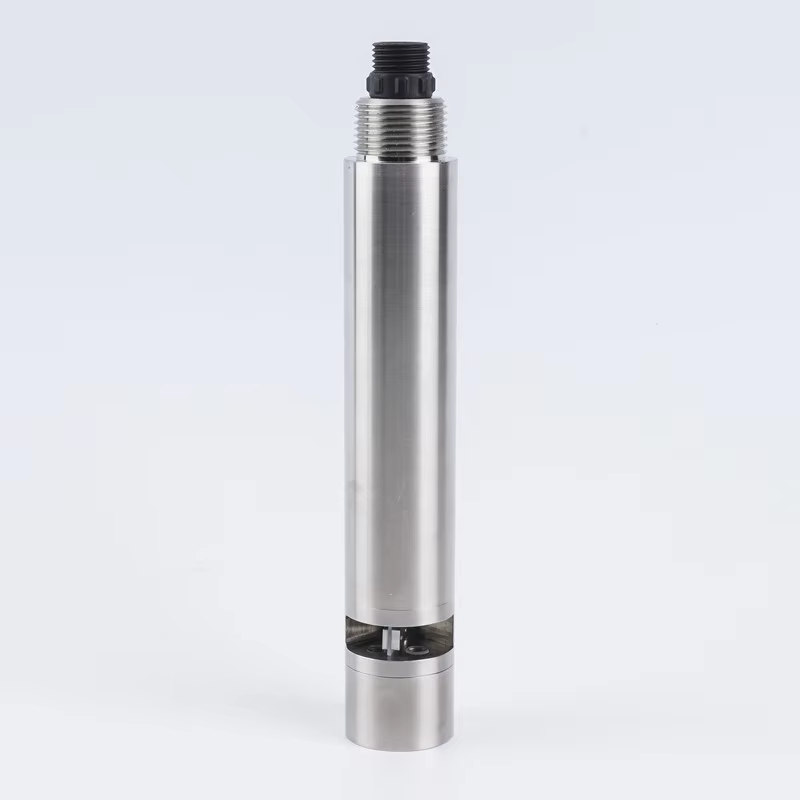Vandens kokybės stebėjimo poreikiai ir drumstumo jutiklių technologijos privalumai
Vietnamas pasižymi tankiais upių tinklais ir ilgomis pakrantėmis, todėl vandens išteklių valdymui kyla daug iššūkių. Raudonosios ir Mekongo upių sistemos tiekia vandenį žemės ūkio drėkinimui, pramoninei gamybai ir kasdieniam gyvenimui, tuo pačiu metu patiriant vis didėjančią taršos apkrovą. Aplinkos monitoringo duomenys rodo, kad suspenduotų nuosėdų koncentracija pagrindinėse Vietnamo upėse lietingųjų sezonų metu gali padvigubėti, palyginti su sausuoju metų laiku, todėl tradiciniams vandens kokybės monitoringo metodams kyla didelių iššūkių.
Dėl savo realaus laiko stebėjimo galimybių drumstumo jutiklių technologija tapo veiksmingu sprendimu Vietnamo vandens kokybės valdymo iššūkiams. Šiuolaikiniai drumstumo jutikliai drumstumo vertėms apskaičiuoti daugiausia naudoja optinius principus, matuodami šviesos sklaidos intensyvumą nuo suspenduotų dalelių, ir siūlo tris pagrindinius technologinius privalumus:
- Didelio tikslumo matavimas: platus diapazonas nuo 0 iki 4000 NTU/FNU su 0,001 NTU skiriamąja geba
- Nuolatinis stebėjimas realiuoju laiku: užtikrina antro lygio reagavimą, kad būtų galima greitai aptikti vandens kokybės anomalijas
- Mažai priežiūros reikalaujanti konstrukcija: higieniški savaime išsivalantys jutikliai gali būti montuojami tiesiai vamzdynuose, taip sumažinant terpės nuostolius
Vietname drumstumo jutiklių taikymas daugiausia skirstomas į tris kategorijas: internetinius jutiklius fiksuotiems stebėjimo taškams; nešiojamus prietaisus lauko bandymams; ir daiktų interneto mazgų jutiklius, kurie sudaro paskirstytų stebėjimo tinklų pagrindą.
Drumstumo stebėjimo taikymas miesto vandens tiekimo ir nuotekų valymo sistemose
Didžiuosiuose miestuose, tokiuose kaip Hošiminas ir Hanojus, drumstumo jutikliai tapo nepakeičiami užtikrinant vandens tiekimo saugą. Higieniški internetiniai drumstumo jutikliai su savaiminio valymo funkcijomis ir skaitmeninėmis sąsajomis gali būti tiesiogiai montuojami vandens paskirstymo tinkluose, kad būtų galima stebėti realiuoju laiku.
Higieninis drumstumo jutiklis, naudojamas daugelyje didelių Vietnamo vandens valymo įrenginių, demonstruoja reprezentatyvų pritaikymą. Naudojant 90° išsklaidytos šviesos principus ir laboratorinio lygio tikslumą, jis ypač tinka išsamiam geriamojo vandens procesų stebėjimui. Veikimo duomenys rodo, kad šie jutikliai padeda palaikyti filtruoto vandens drumstumą mažesnį nei 0,1 NTU, o tai gerokai viršija nacionalinius standartus ir pagerina geriamojo vandens saugą.
Nuotekų valyme drumstumo stebėjimas yra vienodai svarbus proceso valdymui ir išleidimo reikalavimams. Didelė Vietnamo savivaldybės nuotekų valymo įmonė naudoja paviršiuje sklaidomus drumstumo jutiklius antrinio nusodinimo rezervuaro nuotekoms stebėti, integruodama duomenis į gamyklos valdymo sistemas per standartinius signalus. Ataskaitose nurodoma, kad internetinis stebėjimas sutrumpina atsako laiką nuo valandų iki sekundžių, pagerina valymo tikslumą ir padidina nuotekų atitikties rodiklius nuo 85 % iki 98 %.
Novatoriška drumstumo monitoringo praktika akvakultūroje
Vietnamas, antras pagal dydį akvakultūros gamintojas pasaulyje, kurio metinė produkcija viršija 8 milijonus tonų (įskaitant didelę krevečių produkciją), susiduria su tiesioginiu vandens drumstumo pokyčių poveikiu vandens sveikatai. Per didelis drumstumas mažina fotosintezės efektyvumą ir ištirpusio deguonies kiekį.
Ninh Thuan provincijos intensyviuose krevečių ūkiuose įdiegta išmanioji daiktų interneto (IoT) stebėjimo sistema demonstruoja puikius rezultatus. Plūduriu paremta sistema integruoja drumstumo, temperatūros, pH, ištirpusio deguonies ir ORP jutiklius, perduodama realaus laiko duomenis į debesijos platformas belaidžiais tinklais. Praktiniai duomenys rodo, kad šiuose stebimuose tvenkiniuose krevečių išgyvenamumas padidėja 20 %, pašarų konversijos efektyvumas – 15 %, o antibiotikų naudojimas sumažėja 40 %.
Smulkiesiems ūkininkams vietos technologijų įmonės sukūrė atvirojo kodo drumstumo aptikimo sprendimus, kainuojančius mažiau nei 50 USD. Šios sistemos, įdiegtos daugiau nei 300 mažų ūkių Ben Tre provincijoje, padeda sumažinti ūkininkavimo riziką ir stabilizuoti pajamas.
Drumstumo jutiklių taikymas pramoninių nuotekų ir aplinkos monitoringoje
Sparčiai industrializuojant Vietnamą, kyla didelių nuotekų valymo iššūkių, o drumstumas yra pagrindinis reguliuojamas pramoninių išleidimų parametras. Internetiniai drumstumo jutikliai tapo standartine įranga Vietnamo pramoninių nuotekų valymo įrenginiuose, siekiant užtikrinti atitiktį reikalavimams ir išvengti baudų.
Didelis popieriaus fabrikas Šiaurės Vietname demonstruoja drumstumo jutiklių pramoninį pritaikymą. Naudodama trijų pakopų valymo procesus su drumstumo jutikliais kiekvieno etapo įleidimo / išleidimo angoje, gamykla sukūrė išsamius stebėjimo tinklus. Veiklos duomenys rodo, kad šios sistemos pagerino išleidimo reikalavimų laikymąsi nuo 88 % iki 99,5 %, žymiai sumažindamos metines aplinkosaugos baudas ir sutaupydamos cheminių medžiagų sąnaudas.
Aplinkosaugos reguliavime drumstumo jutikliai yra labai svarbūs Vietnamo upių vandens kokybės vertinimo tinklų komponentai. Hibridinės stebėjimo sistemos, apjungiančios palydovinį nuotolinį stebėjimą su Vietnamo vandens išteklių instituto sukurtais antžeminiais jutiklių tinklais, suteikia mokslinį pagrindą tikslingam valdymui. Nuo visiško įdiegimo šios sistemos sėkmingai nustatė pagrindinius taršos šaltinius.
Vietnamo jūrų ekonomikos strategijoje pabrėžiamas griežtas pakrančių vandenų monitoringas. Bandomieji projektai, kuriuose derinami palydoviniai duomenys, mašininio mokymosi algoritmai ir debesų kompiuterijos platformos, sukūrė jūros vandens drumstumo ir kitų parametrų prognozavimo modelius, siūlančius perspektyvius sprendimus 3260 km ilgio Vietnamo pakrantei valdyti.
Taip pat galime pasiūlyti įvairių sprendimų, skirtų
1. Rankinis matuoklis daugiaparametrei vandens kokybei matuoti
2. Plaukiojančių plūdurų sistema, skirta daugiaparametrinei vandens kokybei
3. Automatinis daugiaparametrio vandens jutiklio valymo šepetys
4. Pilnas serverių ir programinės įrangos belaidžio modulio rinkinys, palaikantis RS485 GPRS /4g/WIFI/LORA/LORAWAN
Prašome susisiekti su „Honde Technology Co., LTD.“
Email: info@hondetech.com
Įmonės svetainė:www.hondetechco.com
Tel.: +86-15210548582
Įrašo laikas: 2025 m. liepos 17 d.


